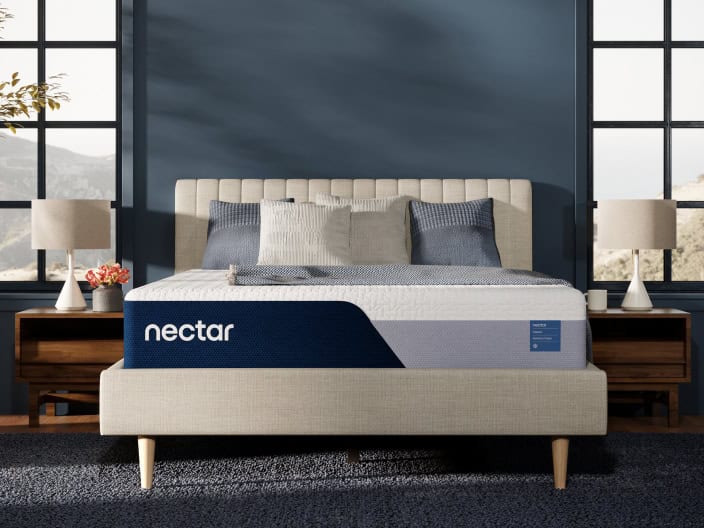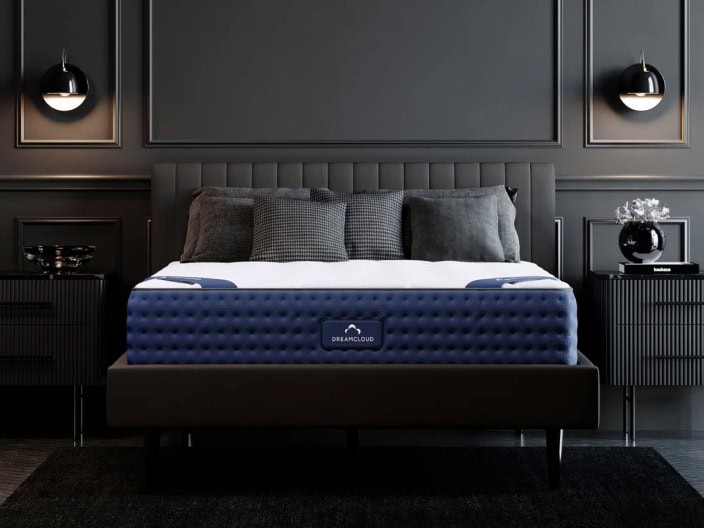What Is High Resilience Foam? Uses, Comparison, Pros, Cons
Share
Fact checked
Reviewed by experts
Updated
December 5, 2022
Quick read
5 mins to read
List of Content
Did you know that back in 1966, NASA developed memory foam, to enhance the performance of aircraft cushions. It was called the Temper foam. It was developed to absorb shock and, offer improved protection and comfort in the airplane seats. Thus, memory foam is now widely used in mattresses and other types of bedding for similar reasons: protection and comfort.
The texture of high resilience foam is soft and cushiony. It conforms to your body’s curves, offering suitable pressure relief. As a result, it is ideal if you suffer from joint discomfort. It’s also suitable for side sleepers who want more cushioning.
What Is High Resilience Foam?
High resilience foam, also known as high resiliency (HR), is a high-grade open-cell foam with a density of 2.5 to 2.8. Its cell structure is incredibly flexible and supportive. The high resilience foam also has a good float and comes loaded with load-distribution properties. As a result, seats, couches, beds, and heavy-duty furniture are ideal.
High-resilience foam is a polymer that combines polyol and isocyanate in a chemical process (two chemicals created from organic compounds). For example, polyurethane is made by mixing polyol and isocyanate in a 2:1 ratio. However, other compounds may be added to give each foam unit the correct amount of flexibility and density.
High-resilience foams aren’t as well-known as memory foam, but they are crucial in many popular mattresses. Memory foam beds’ transitional layer or foundation layer frequently contains high-density, high-resilience foam. This results in a more consistent sensation across the mattress and less shrinking than memory foam.
Like other polyurethane foam, high resilience foam is made up of a polyurethane mix and has a propensity to off-gas. If you have a history of lung problems, you should conduct further study on the reliability of High resilience foams before investing.
High resilience foam is one of the ideal foams in the bedding business because of beneficial characteristics like:
- Durability
- Adaptability
- Support
- Protection, and
- Comfort
This is when critical parameters like density and stiffness come into play. The majority of mattresses are made by stacking various foam and fabric layers. Many famous memory foam manufacturers employ high resilience foam in the intermediate layers. However, greater or lower density foam can be present in the top or base layers.
How high is resiliency foam used in bedding?
The majority of mattresses are made by stacking various foam and fabric layers. Many prominent memory foam brands employ high resilience foam in the middle layers, while more significant or lower density variants can be seen at the top of the foundation layers. You may explore some of the best mattresses as per your preference here.
Pros and Cons of high resilience foam Pros
Pros:
High-resilience foam has numerous advantages that make it ideal for many scenarios.
1. Comfort
High resilience foams are a wonderful choice for clients who want a firm and long-lasting mattress.
The free cell structure of these high resilience foams, instead of the closed-cell structure of closed-cell foams, allows the mattress to keep a bouncy sensation. However, although it stretches and distributes weight effectively, it doesn’t permit much motion transmission from one side to the other.
2. Durability
High-resilience foams are extensively employed in furniture that gets a lot of usages. Particularly in public settings like bus sitting and public building benches.
This is because high resilience foams endure significantly longer than standard foams due to their great flexibility and durability.
3. Cost
High resilience foams are more expensive, so consumers searching for a long-term item with high durability choose them.
Customers believe that high resilience foam and mattresses are worth investing in because of their durability and ability to retain effectiveness for up to 10 years or more.
4. Orthopedic benefits
High-resilience foam and mattresses are delightful, but do they provide other advantages besides comfort and durability?
Well, High resilience foams provide proper weight dispersion and support due to their greater rate of flexibility. As a result, high resilience foams possibly can be employed for various orthopedic applications. For example, in the bedding industry, orthopedic mattresses refer to beds that assist proper sleeping posture, joints, and pain treatment.
Cons
1. Offers a bounce
High-resilience foam and mattresses can be a pain for sensitive sleepers, especially if they share a bed with a partner. This is because these foams, with their tight cell structures, can be more springy than, for instance, a memory foam mattress.
While bounce is a plus for some, it might interrupt sleeping habits for others until they grow accustomed to it. Also, while weight distribution is beneficial, this can make the mattress susceptible to motion transfer, which is present even if it isn’t excessive.
2. Off-gassing
Off-gassing is a prevalent issue with polyurethane-based foams, and high-resilient foams created with a polyurethane mix are no exception.
The breakdown of volatile organic chemicals in mattresses is referred to as off-gassing (VOCs). The high resilience foam and mattress may emit foul odors as a result of this breakdown. This is among the most significant disadvantages of high-resilient foams, and it may be a cause for concern for persons with an acute sense of smell or those who have recurrent respiratory difficulties. While the off-gassing impact is most noticeable at first and is usually very transitory, that is something to consider.
High resilience Foam Has a Number of Uses
However, high resilience foams are beneficial to more than just the bedding sector. Other furniture manufacturers and goods besides mattresses that are routinely and severely used, such as couches, employ this foam.
High resilience foam’s high flexibility, bounce-back solid characteristic, general capacity to keep its form, and durability to endure for a more extended period of time all contribute to this.
Comparison of High resilience Foam With Other Foams
In many ways, high resilience foam is a semi polyurethane foam. It’s not to be mistaken with high-density foam, which is firmer and typically used at the foundation of mattresses and for edge support but not soft enough to lay on. HR foam has a greater return-to-form than memory foam, but it also has less “sink,” which might be a plus.
Here’s a graph that shows how polyurethane foam compares to the other major foam varieties.
| Bed Size | Mattress Measurements | Comforter Width | Comforter Length |
|---|---|---|---|
| Crib | 28 inches by 52 inches | 28 to 36 inches | 48 to 52 inches |
| Twin | 38 inches by 75 inches | 66 to 68 inches | 86 to 88 inches |
| Twin XL | 38 inches by 80 inches | 68 inches | 90 inches |
| Full (Double) | 54 inches by 75 inches | 81 to 84 inches | 86 to 88 inches |
| Queen | 60 inches by 80 inches | 76 inches by 80 inches | 96 to 100 inches |
| King (Eastern King) | 76 inches by 80 inches | 102 inches | 86 to 88 inches |
| California King (Western King) | 72 inches to 84 inches | 107 to 110 inches | 96 to 98 inches |
Conclusion
When buying a mattress, make sure you do your homework to guarantee you receive the best deal. If it has high resilience foam, you’ll at least be aware of what it contributes. We hope that this article helped you in providing a detailed explanation and of all things that one must know about high resilience foam and it contributes in making an average bed, the best!
To know more about mattress sizes and dimensions, pillow sizes and all things sleep, visit sleepauthority.com.
Frequently asked questions
In many ways, high resilience foam is a semi polyurethane foam. It’s not to be mistaken with high-density foam, which is firmer and typically used at the bottom of mattresses and for edge support, but just not soft enough to lay on.
High resilience foam is a type of polyurethane foam that is far more responsive over memory foam, which is slower.
Exposure to isocyanates, one of the primary constituents in High resilience foam, can cause a variety of health concerns, namely asthma, lung problems, respiratory issues, and allergic skin reactions.
This website does not offer medical advice nor professional medical services; rather, it is provided solely for educational, informational, and/or entertainment purposes. Individuals seeking medical advice should consult a licensed physician. The information provided should not be used for diagnosis or treatment of any condition, disease, or injury. When you have a medical condition, you should always talk to licensed doctor or other certified medical professional. You should never delay seeking professional medical advice or treatment based on the contents of this website. Call 911 or immediately go to the nearest emergency room if you think you may have a medical emergency. The contents of this website are provided “as-is”, Sleep Authority and its parent, subsidiaries, affiliates, employees, contributors disclaim any warranty of the information contained herein. Please contact using contact form to report any errors, omissions, misinformation, or abuse.
Sleep Authority is brought to you by Resident, the company that brings you Nectar, DreamCloud, Awara, Wovenly, Bundle, Home Well Designed and Level Sleep.





